Jubilee Marks 50 Years from Book of Mormon Chiasmus Discovery
Contributed By Sarah Harris, Church News staff writer
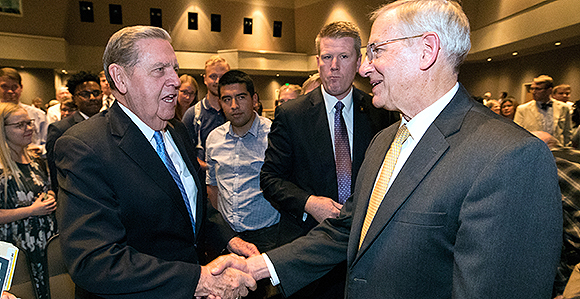
Elder Jeffrey R. Holland of the Quorum of the Twelve Apostles speaks with law and religion scholar John W. Welch after the Chiasmus Jubilee celebrating the 50th anniversary of the discovery of chiasmus in the Book of Mormon.
Article Highlights
- God intends for us to use the evidence He has given that affirms the truthfulness of His work.
- Always be ready to share reasons or evidences for our hope and belief with others.
“Truly rock-ribbed faith and uncompromised conviction comes with its most complete power when it engages our head as well as our heart.” —Elder Jeffrey R. Holland of the Quorum of the Twelve Apostles
Related Links
In his message to hundreds at Brigham Young University on August 16, Elder Jeffrey R. Holland of the Quorum of the Twelve Apostles declared that “the gospel of Jesus Christ is infallibly true and that a variety of infallible proofs supporting that assertion will continue to come until Jesus descends as the ultimate infallible proof of all.”
One such proof for many—celebrated this week with a jubilee and two-day conference sponsored by BYU Studies and Book of Mormon Central—is the discovery of chiasmus in the Book of Mormon 50 years ago.
Chiasmus is an ancient Near Eastern writing style found in the Bible and other ancient texts in which a list of ideas is presented in a deliberate order and then repeated in reverse around a central focal point. John W. (Jack) Welch, a law and religion scholar, found this writing style in Mosiah 5 as a young missionary serving in Germany on August 16, 1967.
Many consider the discovery of this literary form in the Book of Mormon as evidence of the ancient origin of the text. Elder Holland said in his closing remarks at the Chiasmus Jubilee that he believes God intends for us to use the evidence He has given that affirms the truthfulness of His work.
“Our testimonies aren’t dependent on evidence—we still need, always and forever, that spiritual confirmation in the heart,” Elder Holland remarked. “But not to seek for and not to acknowledge intellectual, documentable support for our belief when it is available is to needlessly limit an otherwise incomparably strong theological position and deny us a unique, persuasive vocabulary in the latter-day arena of religious investigation and sectarian debate.”
He said the definition of revelation in Doctrine and Covenants 8:2–3 makes it clear that truth borne by the Spirit comes with two manifestations or witnesses: the force of fact and the force of feeling.
“Truly rock-ribbed faith and uncompromised conviction comes with its most complete power when it engages our head as well as our heart,” Elder Holland said.
Given our knowledge of evidence such as chiasmus in the Book of Mormon, Elder Holland stated, “we ought to be more assertive than we sometimes are in defending our testimony of the truth.”
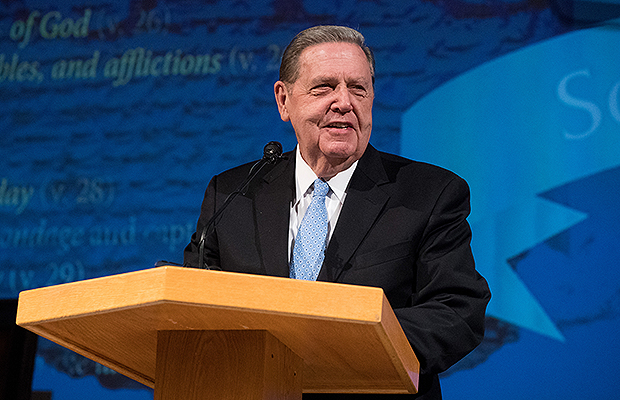
Elder Jeffrey R. Holland of the Quorum of the Twelve Apostles speaks during the Chiasmus Jubilee celebrating the 50th anniversary of the discovery of chiasmus in the Book of Mormon. Photo by Jaren Wilkey, BYU.
Elder Holland referenced the story of the resurrected Jesus Christ visiting the Apostles, when He invited them to touch His hands and feet and “upbraided [those who doubted] with their unbelief and hardness of heart” (Mark 16:14).
“The message there to me is that if members of the Godhead go to the trouble of providing ‘many infallible proofs’ (Acts 1:3) of truth, then surely we are honor bound to affirm and declare that truth, and we may be upbraided if we do not,” Elder Holland asserted.
He also quoted Peter in his charge to always be ready to share reasons or evidences for our hope and belief with others.
“May our Father in Heaven bless us and an ever-larger cadre of young scholars around the Church to do more and more to discover and delineate and declare the reasons for the hope that is in us,” Elder Holland said.
In addition to Elder Holland’s address at the jubilee, the evening’s program—presented as a chiasm itself—included talks from BYU President Kevin J Worthen; Jack Welch; and Elder Kim B. Clark, General Authority Seventy and Church Commissioner of Education.
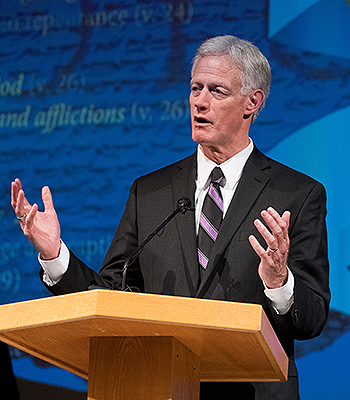
BYU President Kevin J Worthen speaks at the Chiasmus Jubilee held on the BYU campus. Photo by Jaren Wilkey, BYU.
In his opening remarks, President Worthen said his first exposure to chiasmus was through an article about the concept in the February 1972 New Era. He said he walked away from that article knowing that John W. Welch is a really smart guy and that learning about his discovery had strengthened Worthen’s testimony of the Book of Mormon and deepened his understanding of the depth of the message of the scriptures.
“I do want to add one other thing that I think we should celebrate as we think about Jack’s amazing discovery and the work that’s happened since then, and that is the way in which God can take individuals who are consecrated and use them to promote His work,” President Worthen said.
In a video premiere following President Worthen’s remarks, Welch told the story of his discovery of chiasmus in the Book of Mormon. He said in the video that before he finished his mission, he had the opportunity to meet with and explain his discovery to Paul Gaechter, a Jesuit priest whose book on Hebraic literary forms in the gospel of Matthew taught Welch about the concept of chiasmus.
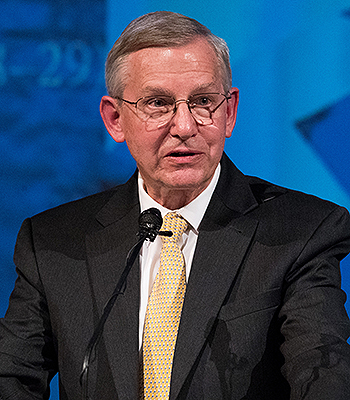
John W. Welch speaks during the Chiasmus Jubilee celebrating the 50th anniversary of his discovery of chiasmus in the Book of Mormon. Photo by Jaren Wilkey, BYU.
Welch recalled in the video Gaechter’s “fatherly” words after Welch’s explanation of the chiasms he had found in the Book of Mormon: “You are a lucky young man. You have found a life’s work.”
This meeting was portrayed in a painting unveiled at the jubilee, created by Robert Pack and titled Life’s Work. Pack explained his inspiration for the painting in a video presentation.
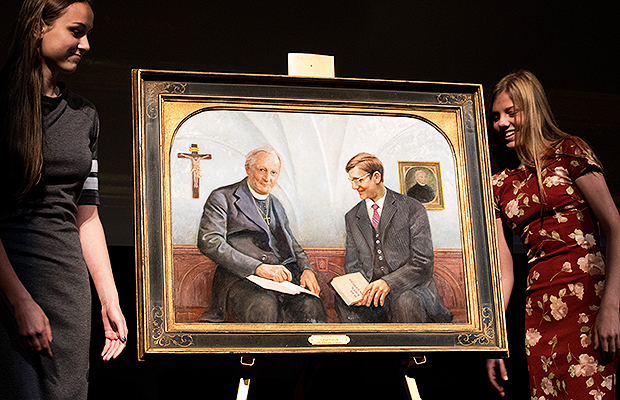
Granddaughters of John W. Welch unveil a painting by Robert Pack commemorating the discovery of chiasmus in the Book of Mormon. Photo by Jaren Wilkey, BYU.
“It is sort of a chiasmic idea in that you have the past that leads into a central point that from which the scholarship continues in reverse from that point of meeting back to all the further discoveries that have now transpired from the Book of Mormon,” Pack said in the video.
In his jubilee remarks, Welch said Alma 36 comes at the top of the list of his favorite chiasms and shared the story of when he first discovered it.
“I remember staring out the window in astonished admiration at what Alma has given us here,” Welch said. “As this chapter’s chiastically repeated elements emerged from the page for the first time, I felt Alma close at hand. He truly communicated the reality of his testimony. I knew, and I testify I knew that he knew it.”
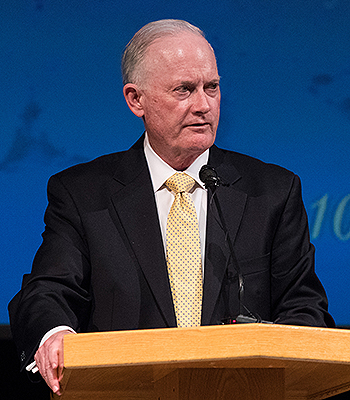
Elder Kim B. Clark, General Authority Seventy and Church Commissioner of Education, speaks during the Chiasmus Jubilee celebrating the 50th anniversary the discovery of chiasmus in the Book of Mormon. Photo by Jaren Wilkey, BYU.
Elder Clark’s jubilee message focused on this chapter and its personal significance to him in its story of the redemption of a wayward child. He testified to parents now praying for a wayward child that what Alma taught is true.
“God does reach for His wayward children and our wayward children,” Elder Clark said. “He reaches for us, and the way home is the Lord Jesus Christ.”
The jubilee included several video and other premieres, including an original vocal number based on Alma 36 titled “How Exquisite Was My Joy,” sung by Welch’s sister, Barbara Welch Cramer.
Several announcements were also made during the event, including the publication of a new book—To Seek the Law of the Lord: Essays in Honor of John Welch—as well as the opening of a chiasmus archive in the BYU Harold B. Lee Library Special Collections and BYU Studies’ online resource chiasmusresources.org
Book of Mormon Central also announced its development of a forthcoming interactive scriptures app. According to a media premiere at the jubilee, the app will allow users to read the scriptures alongside maps, parallel accounts of similar passages, cross-references, dictionaries, prophetic commentary, virtual tours, videos, artwork, music, and other religious multimedia resources.
Welch’s wife, Jeannie S. Welch, said in her jubilee address that she has been amazed at how chiasmus helps people “see beyond the words of an ancient text to understand context and influence and symbols and patterns in the scriptures.”
“Tonight’s celebration has been especially rewarding as I have watched for these many years this idea grow from what seemed originally kind of like a one-man band to this orchestra with these many scholars who come together with their different instruments, playing what sounded today like a symphony as they collaborated, bringing new harmonies that were not yet discovered in holy texts,” Jeannie Welch said.
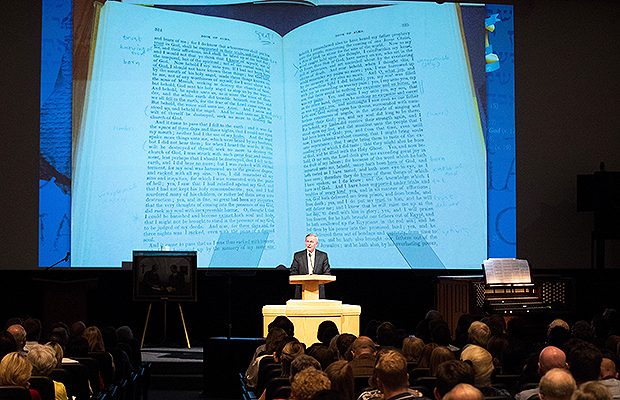
John W. Welch speaks during the Chiasmus Jubilee, showing his markings in the Book of Mormon after he found the chiasm in Alma 36. Photo by Jaren Wilkey, BYU.
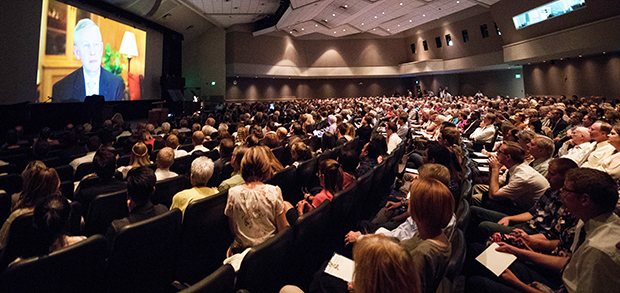
John W. Welch tells the story of his discovery of chiasmus in the Book of Mormon during the Chiasmus Jubilee celebrating the 50-year anniversary of the discovery. Photo by Jaren Wilkey, BYU.
